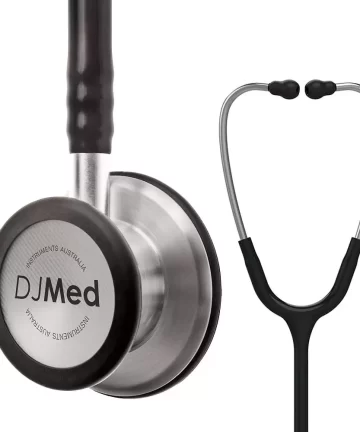Stethoscopes are medical devices used to listen to the internal sounds of the body. They are most commonly used to listen to the sounds produced by the heart, lungs, and abdomen. By listening to these sounds, medical professionals can assess the health of these organs and identify any potential problems.
For example, a doctor might use a stethoscope to listen to a patient’s heart to detect any irregularities in the heart’s rhythm, such as a heart murmur. Similarly, a stethoscope can be used to listen to the sounds produced by the lungs, such as wheezing or crackling, which can indicate conditions such as asthma or pneumonia. Stethoscopes can also be used to listen to the sounds produced by the gastrointestinal tract to identify issues such as bowel obstructions or the presence of fluid in the abdomen.
In addition to these traditional uses, stethoscopes are also used in a variety of specialized medical fields, including cardiology, pulmonology, and obstetrics. In cardiology, for example, stethoscopes can be used to detect the subtle sounds produced by the heart’s valves, which can help diagnose conditions such as valvular heart disease. In obstetrics, stethoscopes can be used to listen to the fetal heartbeat during pregnancy.
They are an essential tool for medical professionals in diagnosing and treating a wide range of medical conditions. They allow doctors and other healthcare professionals to listen to internal sounds that cannot be heard with the naked ear and provide valuable information that can aid in diagnosis and treatment planning.
What is the Role of Stethoscopes in Medical Practice?
Stethoscopes play an indispensable role in the medical profession. Primarily, they’re used for auscultation – the act of listening to internal body sounds. These medical devices allow health professionals to monitor the heart, lungs, and abdomen, thereby helping in the early detection and diagnosis of various health conditions.
For instance, by auscultating a patient’s heart, a doctor may identify rhythm irregularities like heart murmurs. Likewise, listening to lung sounds can help detect conditions like asthma or pneumonia, while sounds from the gastrointestinal tract can reveal issues like bowel obstructions or fluid present in the abdomen.
Moreover, stethoscopes find usage beyond these traditional applications. They are instrumental in specialized medical fields such as cardiology, pulmonology, and obstetrics. In cardiology, subtle sounds produced by the heart’s valves can help diagnose conditions like valvular heart disease, while in obstetrics, fetal heartbeats can be monitored during pregnancy.

How has the Stethoscope Evolved?
The stethoscope, an essential medical tool, has a history dating back over two centuries. French physician René Laennec invented it in 1816 as a solution to the discomfort and inefficiencies associated with direct auscultation, which involved placing the physician’s ear directly onto the patient’s chest.
The first stethoscope was a hollow wooden tube, about one inch in diameter and 10-12 inches long. Laennec discovered this device could amplify chest sounds, facilitating better interpretation of heart and lung sounds. The term “stethoscope” derives from the Greek words “stethos” (chest) and “skopein” (to examine).
Initially, stethoscopes were monaural, having only one earpiece, allowing the physician to hear surrounding sounds such as the patient’s breathing or speech. Later, binaural stethoscopes were introduced with two earpieces for simultaneous listening with both ears.
Over time, the stethoscope’s design improved, and materials like stainless steel, aluminium, and plastics were introduced to enhance its acoustic properties. Today’s stethoscopes come in various shapes, sizes, and colours. Some are electronic, allowing physicians to amplify and record sounds for later analysis.
What are the Classic Stethoscopes?
Despite advancements in stethoscope technology, classic stethoscopes remain in demand. One renowned manufacturer of classic stethoscopes is DJMed. Founded in 1979, DJMed is known for producing high-quality, durable, reliable, and accurate stethoscopes. They handcraft these devices from fine materials to meet the highest standards.
The DJMed classic stethoscopes come in various models, each with unique features. The DJMed Classic II, for example, has a double-sided stainless steel chest piece for listening to both low and high-frequency sounds. Another popular model, the Classic III, has a lightweight aluminium single-sided chest piece, ideal for pediatrics.
Classic stethoscopes, like those from DJMed, come in a range of colours, allowing medical professionals to personalize their devices. Despite their simplicity, these classic stethoscopes are reliable and can be used anywhere, without worrying about battery life or complex electronics.

What are the Advantages of Using Stethoscopes?
- Abnormality Detection: Stethoscopes allow medical professionals to detect abnormal internal organ sounds, indicating various medical conditions.
- Non-invasive: Stethoscopes provide a non-invasive method to assess the health of internal organs, ensuring patient comfort.
- Portability: Being lightweight, stethoscopes can easily be carried around, making them useful in various settings such as hospitals, clinics, and even remote locations.
- Cost-effective: Compared to other medical equipment, stethoscopes are relatively inexpensive, making them accessible to professionals across different work settings and budgets.
- Versatility: Stethoscopes can assess the health of various organs and are useful in multiple medical specialties, making them a versatile tool for medical professionals.
Why are Classic Stethoscopes Still in Demand?
In conclusion, the demand for classic stethoscopes, like those produced by DJMed, remains strong among medical professionals worldwide. Known for their durability, reliability, and accuracy, these stethoscopes are meticulously handcrafted from the finest materials. They come in a variety of models and colours, adding a personal touch for medical professionals.
Classic stethoscopes are simple yet effective tools that can be used anywhere, free from concerns about battery life or the need for complex electronics. If you’re in the market for a stethoscope, consider investing in a classic stethoscope from DJMed, available through the MyMedici online store. It’s a sound investment in your medical practice.
Sources:
- “History of the Stethoscope.” MedlinePlus, U.S. National Library of Medicine, 1 Apr. 2020, medlineplus.gov/ency/article/002305.htm.
- “Stethoscope.” Encyclopedia Britannica, 27 Oct. 2020, britannica.com/technology/stethoscope.





